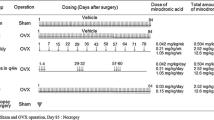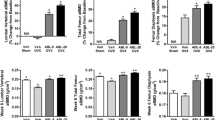Abstract
A total of 22 female patients under age 60 who showed a decrease in bone mineral density (BMD) after menopause and/or bilateral oophorectomy received 600 mg/day ipriflavone (IP) for 1 year, and the effects on bone metabolism and BMD were observed. Although estrogen levels were low in these patients, a significant rise in serum calcitonin and a decrease in serum calcium were observed. Osteocalcin, a bone formation indicator, also showed a significant increase. These findings suggest IP both inhibits bone resorption and promtes bone formation not only in vitro but also in vivo. BMD of cancellous bone was measured using quantitative computed tomography (QCT). Cancellous bone is believed to most sensitively reflect changes in bone metabolism because of its high rate of metabolic turnover [1]. The patients who had not received IP showed a significant decrease in BMD, while those who had received IP showed only a slight decrease. These observations suggest that IP can be used successfully to reduce the rapid decrease in bone density associated with menopause and/or bilateral oophorectomy.
Similar content being viewed by others
References
Riggs BL, Melton LJ III. Medical progress: Involutional osteoporosis. N Engl J Med 1986;314:1676–1686
Trends in national public hygeine—Health and Welfare Statistics Association. 1991;38:37–42
Ohta H, Makita K, Suda Y, et al. Osteoporosis: Medication selection and current evaluation. (in Japanese) Clin Gynecol Obstet (in press)
Ohta H, Masuzawa T, Ikeda T, et al. Influence of oophorectomy on serum levels of sex steroids and bone metabolism and the assessment of bone mineral density in lumbar trabecular bone by QCT-C value. J Bone Miner Res 1992;7:659–665
Ohta H, Nemoto K. Measurement of bone mineral content in the 3rd lumbar vertebra by computed tomography with a phantom and evaluation of its clinical applications. (in Japanese) J Obstet Gynecol Tokyo Jpn 1988;37:215–220
Tsuda M, Kitazaki T, Ito T, et al. The effect of ipriflavone (TC-80) on bone resorption in tissue culture. J Bone Miner Res 1987;1:207–211
Yamazaki I. Effect of ipriflavone on the response of uterus and thyroid to estrogen. Life Sci 1986;38:757–764
Yamazaki I, Kinoshita M. Calcitonin-secreting property of ipriflavone in the presence of estrogen. Life Sci 1986;38:1535–1541
Benvenuti S, Tanini A, Frediani U, et al. Effects of ipriflavone and its metabolites on a clonal osteoblastic cell line. J Bone Miner Res 1991;6:987–996
Fujita T, Yoshikawa S, Ono K, et al. Usefulness of TC-80 (ipriflavone) tablets in osteoporosis: Multicenter double-blind, placebo-controlled study. (in Japanese) Igaku no ayumi 1986;138:113–141
Yoshida K, Shiraishi H, Nishiyama S, et al. Lumbar bone mineral density in normal and osteoporotic Japanese. (in Japanese) J Jpn Orthop Assoc 1990;64(2)(3):S163
Agnusdei D, Zacchei F, Bigazzi S, et al. Metabolic and clinical effect of ipriflavone in established postmenopausal osteoporosis. Drugs Exp Clin Res 1989;15:97–104
Yamazaki I, Shino A, Tsukuda R. Effect of ipriflavone on osteoporosis induced by ovariectomy in rats. J Bone Miner Metab 1986;3:205–210
Hashizume K, Yamauchi K, Suzuki S, et al. Effect of ipriflavone on diabetic osteoporosis—Analysis of ipriflavone-induced calcitonin secretion. (in Japanese) New Drugs Clin Appl 1992;35:75–83
Ohta H, Nemoto K, Nozawa S, et al. Changes in bone mineral content and bone metabolism related to menopause. (in Japanese with English abstract) Acta Obstet Gynecol Jpn 1989;41:1447–1454
Ohta H, Nemoto K, Nozawa S, et al. Mechanisms of the decrease in metacarpal bone mineral content due to oophorectomy. (in Japanese with English abstract) Acta Obstet Gynecol Jpn 1989;41:333–340
Ohta H, Nemoto K, Nozawa S, et al. Assessment of osteopenia following oophorectomy by quantitative computed tomography and its relation with Ca-regulating hormones. (in Japanese with English abstract) Acta Obstet Gynecol Jpn 1989;41:1471–1478
Schmid C, Ernst M, Zapf J, et al. Release of insulin-like growth factor carrier proteins by osteoblasts: Stimulation by estradiol and growth hormone. Biochem Biophys Res Commun 1989;160:788–794
Gray TK, Mohan S, Linkart TA, et al. Estradiol stimulates in vitro the secretion of insulin-like growth factors by the clonal osteoblastic cell line UMR106. Biochem Biophys Res Commun 1989;158:407–412
Author information
Authors and Affiliations
About this article
Cite this article
Ohta, H., Komukai, S., Ikeda, T. et al. The influence of ipriflavone on bone metabolism and reduction of bone mineral density decrease by ipriflavone following menopause or bilateral oophorectomy. J Bone Miner Metab 11 (Suppl 1), S40–S45 (1993). https://doi.org/10.1007/BF02378749
Issue Date:
DOI: https://doi.org/10.1007/BF02378749




